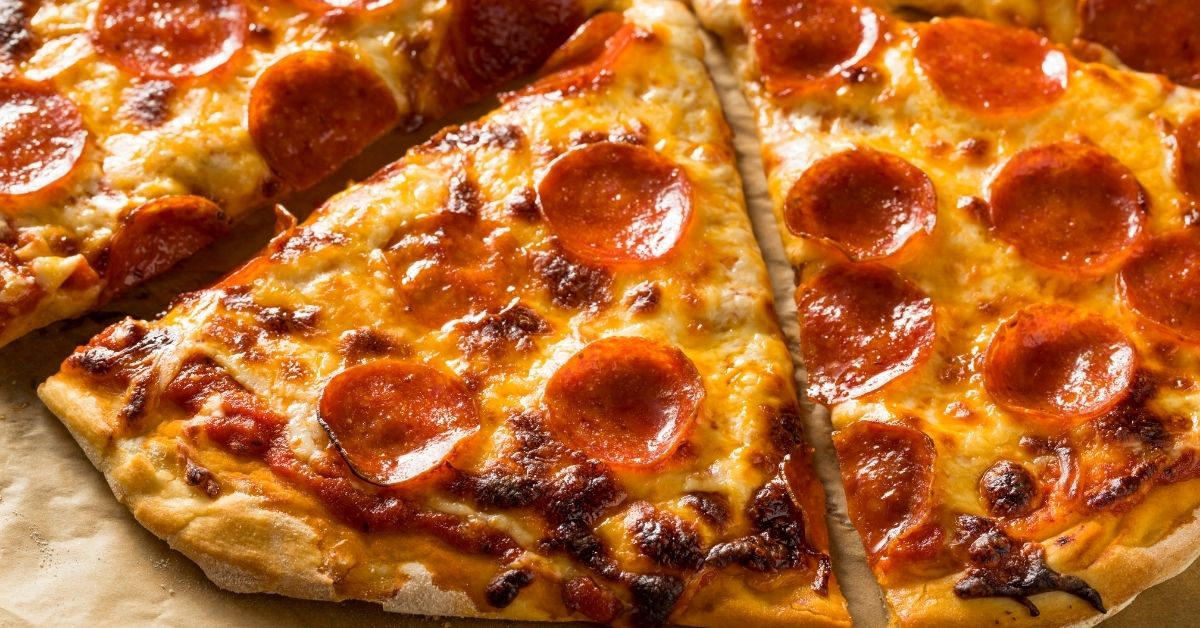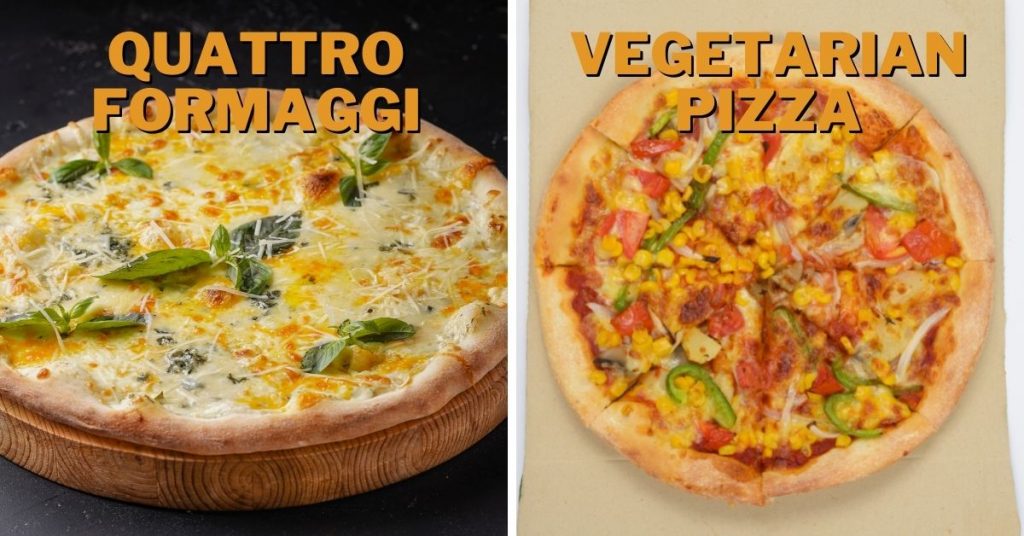Why Is Pizza Greasy and How to Fix It?

No matter what pizza toppings you use, pizza is considered a greasy dish. Whether vegetarian or meaty, your pizza will always leave a greasy spot. So if the toppings aren’t the only determinants, why is pizza greasy and how to fix it?
Pizza is greasy because it contains oil in the crust and grease in the pizza sauce and cheese. The toppings sure play a significant role here so that a meaty pizza will be greasier than a mushroom pizza. However, no pizza is grease-free.
Getting the amount of grease in pizza is crucial, as using too little fat can result in a hard crust and dry pizza. On the other hand, a more considerable amount of grease can make your pizza heavy, unappealing, and hard to digest.
As a huge pizza fan, I’ve acquired some knowledge in this subject, and I am gladly passing it on, so in the following paragraphs, you will find some valuable information on how to manage the grease amount, which pizza is greasiest, and the differences between cold and hot pizza.
Why Is Pizza So Greasy?
Pizza toppings are a major factor in why your pizza is greasy.
The cheesier and meatier the pizza is, the greasier it will be. Take Gouda cheese as an example. In one ounce of Gouda, there are 8 grams of fat. However, vegetarian pizzas are greasy too, so apparently, the toppings aren’t the only players.
The pizza dough is quite fatty, and you must have pizza dough to have pizza, so no matter what you put on it, the pizza will be greasy because there is grease in the dough.
Another thing is baking. Since baking is basically dehydrating, all the grease in the dough combines with the grease of the toppings, and all toppings contain fatty elements. You may be baking a vegetarian pizza, but that doesn’t change the fact that everything has its own natural amount of fat, therefore whatever you use as the topping will release some amount of grease.
The pizza sauce also plays a part in the greasiness of the pizza. Usually, the store-bought sauces tend to be fattier than the homemade ones, as they contain more sugars, thickeners and oil.
How to Keep Pizza From Getting Greasy?
First of all, fat doesn’t have to be a bad thing. Grease adds flavor to pizza, gives it character, and is a natural part of it. If you want a fat-free pizza, you might be desiring the impossible.
However, if you are a pizza lover but not a fat lover, there are some things you might be able to do to decrease the amount of fat and grease in your pizza and still enjoy its juiciness.
Still, whatever you do, don’t tamper with the pizza dough, but rather experiment with the other elements.
Mozzarella or Feta Instead of Full-Fat Cheese
As seductive as it is, cheesy pizza is one of the greasiest. The melted cheeses combined with the natural crust grease can form a fat bomb. So to enjoy your pizza and not worry about its fat content, switch to mozzarella or feta instead of full-fat cheese.
Mozzarella and feta will melt perfectly in your pizza but won’t add fat or grease, as they are both low in fat and calorie. The flavor would remain the same, if not better because mozzarella and feta mix excellently with a variety of dishes.
Precook Meaty Toppings
Pepperoni and bacon are among the tastiest pizza toppings, but their grease content is unbelievable. When cooked on top of your pizza, they release all the fat they contain and become crispy, but the fat isn’t going anywhere. Therefore you will see small puddles of grease on your pizza, and if you don’t want them, you can precook the toppings.
Precooking the meaty toppings will make them significantly less fatty but will also decrease their flavor. Putting your bacon into the microwave or frying it for a few minutes before you top your pizza will do the trick here but don’t expect the same flavor.
Change Your Meaty Toppings
There are substitutes for everything, so if you don’t want to precook your toppings, you might want to consider changing them. Most of these toppings are made of pork, so they are greasier. Switching from pork bacon to turkey bacon and from pork and beef pepperoni to all beef pepperoni will reduce the grease amount in your pizza.
Of course, your pizza won’t taste the same; depending on your preferences, you will either like it better or you won’t. However, switching your toppings from pork to turkey or beef will make your pizza less greasy.
Changing the Crust
As a rule, deep-dish pizza is greasier than thin-crust or pan pizza. So if you aim to reduce the grease and fat in your pizza, choose one of the less fatty options. If you decide to do the crust yourself, do not experiment with it; stick to the recipe and choose the less greasy crust variant.
Using Fresh Tomato Sauce
The kind of sauce you use in your pizza will also influence its fat content. Using fresh tomato sauce will significantly reduce the fat content, but it will add moisture. After blending the tomatoes for sauce, leave them in the strainer for a while, and this way, you will have a nice tomato sauce without excess fat or moisture.
Avoid store-bought tomato sauces, as they contain a lot of fats and sugar, which will undoubtedly be absorbed in your pizza.
Cook Your Pizza at Higher Temperatures
The higher the temperature, the drier the pizza. Baking your pizza at higher temperatures will decrease the fatty content, as the heavy toppings will cook for less time, and they won’t release as much grease and fat into the crust as they would in lower temperatures, though their caloric value won’t change.
However, baking your pizza at higher temperatures will result in a slightly overdone pizza with a hard crust; if you can tolerate this, then go ahead.
How to Take Grease Off Pizza?
It is easier to add some extra grease than to take it off, but sometimes it has to be done. If you overdo the fatty toppings, they will release some substantial amount of fat that you may not like on your pizza. In this case, you will have to remove the excess grease, which isn’t always simple, but it is doable.
Blotting
The easiest way to remove excess grease from your pizza is to blot it. Tap the pizza with a paper napkin to absorb the fat puddles. However, blotting the pizza will only remove the surface grease, leaving the rest of the pizza as greasy as it was before.
Still, you can remove a good amount of fat and grease this way, making your pizza more user-friendly. There is, however, of making your pizza externally dry, so pat slowly and softly, and be careful not to leave any paper napkin pieces on your pizza, as the napkin can stick to the grease and become hard to remove.
Tapping With Bread
Bread is very absorbent, especially when it comes to grease. So to reduce the fat and grease amount in your pizza, you may want to tap it with a slice of bread. This degreasing is very simple, but you should be careful not to press too much on the pizza and not to remove some of the sauce or toppings.
Whatever you decide to do, whether blotting or tapping your pizza with bread, you risk whipping away the spices and flavors, so be very careful and gentle when doing either of them both.
What Is the Greasiest Pizza?
There isn’t only one type of pizza to give here. As pizza is a greasy dish, which one will be the greasiest depends on the toppings.
Cheesy pizzas, such as quattro formaggi, are very greasy because they contain four different kinds of cheese. The cheeses in this pizza melt and go into the crust, but a very big part remains on the surface. As delicious as this pizza is, you cannot avoid the small grease puddles on top.
Meaty pizzas are also very greasy; a good example here is the quattro stagioni pizza. This pizza traditionally contains ham and prosciutto, but many of its variations have pepperoni or bacon. These meaty toppings release fat and grease and make this pizza one of the greasiest.
Another example of a very greasy pizza is the Chicago Pizza, topped with ground beef, sausages, and pepperoni covered with tomato sauce. The three types of meat this pizza contains make it incredibly delicious but just as greasy.
Detroit Pizza also enters this category with pepperoni and cheese as its topping. The mix of pepperoni and cheese results in high grease content and high-fat amounts. The pepperoni alone can account for most of the grease, but pair them with the cheese, and you get a grease bomb.
In general, pizzas that contain meat and cheese are greasier than vegetarian ones. Still, you shouldn’t underestimate the grease amount of vegetarian pizzas because the pizza sauces also impact the fat content. Also, vegetarian pizzas still have cheese, and as you saw from the previous paragraphs, cheese is a significant factor in the greasiness of the pizza.

Is Cold Pizza Less Greasy?
Pizza is traditionally served hot, and it is meant to be consumed that way. However, there are many cold pizza lovers, so there must be a reason for that. It is a well-known fact that cold food tastes more intensely than hot food.
Cold pizza tastes differently from hot pizza; it is more user-friendly, as the sauce and toppings have homogenized and seem less greasy. Still, the grease hasn’t gone anywhere, so it would be wrong to say that cold pizza is less greasy than a hot pizza.
Cold pizza only gives the impression of being less greasy since the grease isn’t runny. The cooling process hardens the grease. For example, butter seems less greasy when it is in the fridge because the cold made it hard, and once it is out, it starts to melt and drip, which is where its greasiness becomes visible.
The same goes for pizza too. Just because it is cold doesn’t mean that the grease has gone somewhere, but rather, it became solid.
Is Cold Pizza Healthier Than Hot Pizza?
Pizza can be a surprisingly healthy option, but an unhealthy one as well. The temperature doesn’t change much, as the ingredients remain the same. [1]
In general, whatever pizza you eat is likely to have protein, carbs, and fiber, so it is a healthier choice than cereal, for example. Still, whether your pizza will be beneficial or not depends on what you put in it.
Homemade pizzas are always the healthier option, as you know what you eat. Avoid processed meats and use as many fresh ingredients as you can, and the more green stuff on your pizza, the better.
In terms of temperature, although not healthier than hot pizza, cold pizza doesn’t pose any health risks, as long as it hasn’t been out long enough to go bad. Hot or cold, it’s the same pizza; the only difference is the taste.
Does Cold Pizza Have Fewer Calories Than a Hot Pizza?
Whether hot or cold doesn’t affect the caloric value, the calories remain the same, no matter the temperature. This is because the natural cooling process of the pizza doesn’t influence its nutritional value. If there is a change in the number of calories, it would be negligible.
The pizza needs to be either overdone or frozen to trigger nutritional value changes. Just leaving it out to cool down or putting it in the freezer won’t change much. Other than making it more compact and solid, the cooling won’t other ways affect the pizza.
